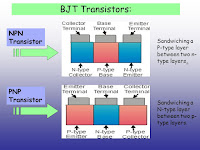BiCMOS
BiCMOS is an evolved semiconductor technology that integrates two formerly separate semiconductor technologies, those of the bipolar junction transistor and the CMOS transistor, in a single integrated circuit device.
Bipolar junction transistors offer high speed, high gain, and low output resistance, which are excellent properties for high-frequency analog amplifiers, whereas CMOS technology offers high input resistance and is excellent for constructing simple, low-power logic gates. For as long as the two types of transistors have existed in production, designers of circuits utilizing discrete components have realized the advantages of integrating the two technologies; however, lacking implementation in integrated circuits, the application of this free-form design was restricted to fairly simple circuits. Discrete circuits of hundreds or thousands of transistors quickly expand to occupy hundreds or thousands of square centimeters of circuit board area, and for very high-speed circuits such as those used in modern digital computers, the distance between transistors (and the minimum capacitance of the connections between them) also makes the desired speeds grossly unattainable, so that if these designs cannot be built as integrated circuits, then they simply cannot be built.
In the 1990s, modern integrated circuit fabrication technologies began to make BiCMOS a reality. This technology rapidly found application in amplifiers and analog power management circuits, and has some advantages in digital logic. BiCMOS circuits use the characteristics of each type of transistor most appropriately. Generally this means that high current circuits use metal–oxide–semiconductor field-effect transistor (MOSFETs) for efficient control, and portions of specialized very high performance circuits use bipolar devices. Examples of this include radio frequency (RF) oscillators, bandgap-based references and low-noise circuits.
Advantages:
In general, BiCMOS devices offer many advantages where high load current sinking and sourcing is required. The high current gain of the NPN transistor greatly improves the output drive capability of a conventional CMOS device.
Disadvantages:
BiCMOS as a fabrication process is not currently as commercially viable for some applications, such as microprocessors, as with exclusively BJT or CMOS fabrication. Unfortunately, many of the advantages of CMOS fabrication, for example, do not transfer directly to BiCMOS fabrication.
Advantages:
In general, BiCMOS devices offer many advantages where high load current sinking and sourcing is required. The high current gain of the NPN transistor greatly improves the output drive capability of a conventional CMOS device.
MOS speed depends on device parameters such as saturation current and capacitance. These in turn depend on oxide thickness, substrate doping and channel length.
Compared to CMOS, BiCMOS’s reduced dependence on capacitive load and the multiple circuit and I/Os configurations possible greatly enhance design flexibility and can lead to reduced cycle time (i.e., faster circuits).
BiCMOS is inherently robust with respect to temperature and process variations, resulting in less variability in final electrical parameters, resulting in higher yield, an important economic consideration.
Large circuits can impose severe performance penalties due to simultaneously switching noise, internal clock skews and high nodal capacitances in critical paths - BiCMOS has demonstrated superiority over CMOS in all of these factors.
BiCMOS can take advantage of any advances in CMOS and/or bipolar technology, greatly accelerating the learning curve normally associated with new technologies.
Disadvantages:
BiCMOS as a fabrication process is not currently as commercially viable for some applications, such as microprocessors, as with exclusively BJT or CMOS fabrication. Unfortunately, many of the advantages of CMOS fabrication, for example, do not transfer directly to BiCMOS fabrication.
An inherent difficulty arises from the fact that optimizing both the BJT and MOS components of the process is impossible without adding many extra fabrication steps and consequently increasing the process cost. Finally, in the area of high performance logic, BiCMOS may never offer the (relatively) low power consumption of CMOS alone, due to the potential for higher standby leakage current.
An exclusive mix of BiCMOS and CMOS has appeal if the performance attributes of each type of gate can be optimized. But since CMOS is already ideal for pure digital logic, this is only a serious issue when it is desirable to put logic circuits together on the same chip with other circuits that are not strictly logic: either for the purpose of a mixed-signal application, or simply to reduce the chip count in an electronic product by combining two chips into one, in order to reduce cost, size, and/or weight.



No comments:
Post a Comment